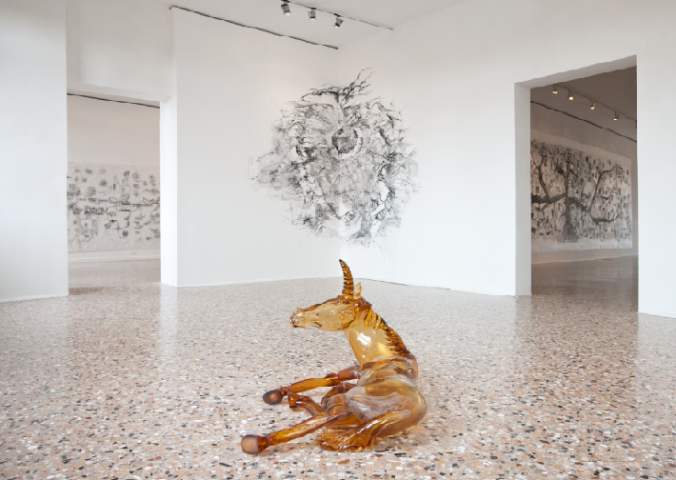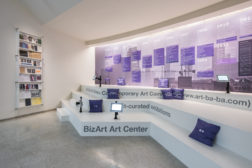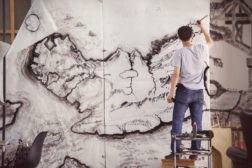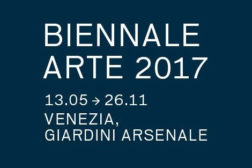


Venice Art Biennale: Qiu Zhijie Exhibition
The Unicorn and the Dragon, A map of the collections of Fondazione Querini Stampalia and Aurora Museum, Shanghai
Exhibition: May 29th to August 18th, 2013
Press Preview: May 28th from 10:00 am to 2:00 pm
Opening: May 28th at 6:00 pm
Curated by: Chiara Bertola and Davide Quadrio
Researcher: Francesca Girelli
Artist Qiu Zhijie, chief curator of the last edition of the Shanghai Biennale, will present at the Querini Stampalia Foundation a selection of new works on the occasion of his first solo exhibition in Italy during the 55th edition of the Venice Art Biennale. Through a comprehensive and diverse range of works, the artist will explore the complex dynamics that outline space and time routes between the East and the West, the Past and the Present.
Considered a true intellectual in the Renaissance meaning of the word, Qiu Zhijie is all encompassing—a thinker, an artist, a cartographer and even an archivist of knowledge. Nobody could explore these intricate paths that span parallely across time and space better than he. As an artist Qiu Zhijie defines his moudus operandi as total art, centered on the awareness that artistic creation cannot be uprooted from the artist’s historical and cultural background.
This exhibition of Qiu Zhijie’s is the first stage of New Roads, a three-year international cooperative project between China and Italy, born from the will to create a platform for intercultural dialogue through contemporary art.
There are three institutions involved: the Aurora Museum of Shanghai, the Fondazione Querini Stampalia in Venice, which, through the critical intercultural intervention and artistic mediation of Arthub Asia, will compare their history and their collections, analyzing and expanding them with projects commissioned from Eastern and Western contemporary artists.
The site-specific works by Qiu Zhijie, as well as all the previous contemporary art projects included in the program Sustaining the Future, developed at Fondazione Querini Stampalia since the year 2000, are designed in relation to the objects within the permanent collection. In this case, the comparison and analysis will extend beyond the usual project, building conceptual and stylistic bridges between the works of the Venetian foundation and the valuable collection of ancient Asian Art at the Aurora Museum of Shanghai.
Transcending the geographical distance and exposing the prejudices built over centuries of cultural exchange between the East and the West, the mapping approach used by Qiu Zhijie trails, discovers and highlights the connections between the two museums along with those between Venice and Shanghai, two cities sharing many features, including their intrinsic attitudes towards external influences and exchange, typical of many places overlooking the sea.
Looking at the maps of this Chinese artist, one can easily notice the similarity in the organic fluidity of the sinuous and dense map of Venice. Qiu Zhijie draws up his maps detecting a system of typologically classified cells, which are consolidated, each one with the others, in a similar way as the places that form the urban texture of the Serenissima. This mutual link between these conceptual cells give life to extraordinary cartographies that, like big turned tapestries, narrate the many knots and wires that interlock them together.
The title of the exhibition The Unicorn and the Dragon, A map of the collections of Fondazione Querini Stampalia and Aurora Museum is inspired by Umberto Eco’s conference, They were looking for unicorns, held at Peking University in 1993. The renowned scholar, analyzing the mechanisms that arise when discovering and comparing different cultures, pointed out a tendency that has existed for centuries to classify symbols, ideas and concepts of foreign cultures by adapting them to our cultural reference system. The most significant case quoted by Eco is that of Marco Polo who, when seeing a rhino during his travels in the East, immediately identified it as a unicorn, in keeping with the classification for defining a creature with a horn that Western tradition had so far made available to him.
The new series of maps by Qiu Zhijie, some of them produced on paper using an ancient Chinese technique of dab rubbing and others drawn with ink directly on site, will expose these very bizarre misunderstandings that stem from the relations of cultural exchange between Italy and China and in a broader sense between the East and the West. Using multiple historical, philosophical and figurative references, the artist will take us through the history and evolution of these mystifications and will help us discover how these misleading interpretations could be fundamental in the discovery of new and unexpected cross-cultural analogies.
Marco Polo’s mistake is very obvious and emblematic, but through Qiu Zhijie’s intervention we can explore the overarching issue more deeply; he further teaches us that in the traditional Chinese culture there were also unicorns, although they were not horses with a horn, nor rhinoceroses. One of these Chinese unicorns is a particular creature called Bixie or Tianlu, which surprisingly, in some representations among the Aurora collection appears similar to the Saint Mark’s lion.
The artist’s works are also focused on the transformation process of those cultural iconographies that, even if originally stemmed from antique seeds, are then adulterated and transformed through the interaction and transmission of—and between—cultures.
These hybrids of mystical significance will be represented by Qiu Zhijie in a series of sculptures of mythological animals created by the combination of images sourced from two warehouses of memory: the collections of the Querini Stampalia and the Aurora Museum.
For further information and images please visit here.
Fondazione Querini Stampalia
Santa Maria Formosa, Castello 5252, 30122 Venezia
Telephone: 041 2711411 Fax: 041 2711445
Ufficio stampa Sara Bossi
Cell: 339 8046499 Telephone: 041 2711441
E-mail: s.bossi@querinistampalia.org
In collaboration with Studio ESSECI, Sergio Campagnolo
Telephone: 049 663499
E-mail: gestione3@studioesseci.net




